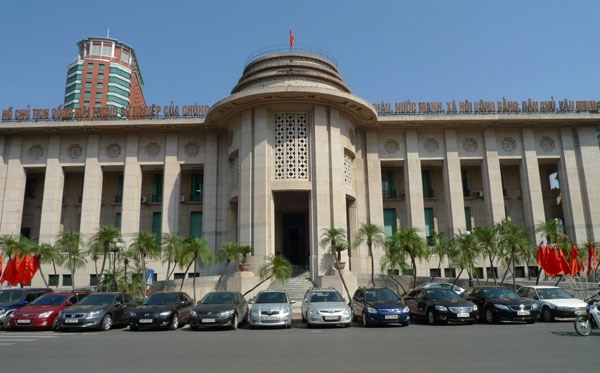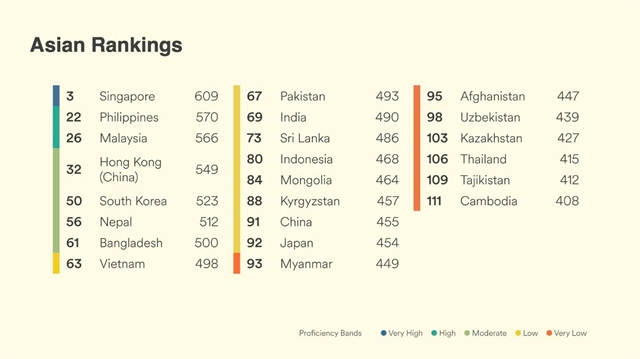 Economy
Economy

The State Bank of Việt Nam is collecting feedback for a decree on gold trading, which will include a monopoly for the central bank on accepting gold deposits.
 |
compiled by Thiên Lý
The State Bank of Việt Nam is collecting feedback for a decree on gold trading, which will include a monopoly for the central bank on accepting gold deposits.
The new decree will supersede Decree No.24/2012/NĐ-CP and get rid of certain conditions for companies that make gold jewellery.
Decree No.24 confers on the Government a monopoly on gold bullion production and import and export of the metal.
It classifies bullion trading as a conditional business requiring institutions and individuals to obtain a license from the central bank.
To get a licence they should have a capital of at least VNĐ100 billion (US$4.7 million), a distribution network covering at least three provinces or centrally-administered cities, at least two years experience in the gold trade and paid taxes on gold trading of over VNĐ500 million (23,800) for at least two years when the business was not restricted.
Before Decree No.24 was issued, gold deposits and loans by banks had been stopped in November 2012 under the central bank’s Circular No.11/ 2011/TT-NHNN.
Before 2012 the gold market had been very volatile. Banks’ acceptance of gold deposits and lending had greatly impacted the liquidity of the banking system and even caused economic instability.
In the five years since, Decree No.24 has reduced the importance of gold in the economy and stabilised the gold market. Gold price movements no longer affect foreign exchange rates and, thus, economic stability.
The precious metal is no longer the attractive asset class it used to be.
So, with the sailing in the gold market being smooth, why does the central bank feel the need to issue an amended Decree 24?
In August the Government Office wrote to the central bank governor, Lê Minh Hưng, informing him the State Bank of Việt Nam should “continue focusing on research and implementation of appropriate solutions to mobilise foreign currency and gold from the people to serve development and investment.”
At a recent meeting with the governor, the Prime Minister’s Working Group led by Government Office chairman, Mai Tiến Dũng, againt stressed the need to mobilise foreign exchange and gold.
Dũng said Việt Nam’s decision to ban gold deposits and reduce interest on dollar deposits to zero have helped restrict the pervasive influence of the dollar and gold on the economy and prevent chaos in the market, since people have stopped using them as a means of payment.
However, an estimated 500 tonnes of gold is held by the public, which, if brought into the market, would be good for the economy.
To enable this, the central bank found it necessary to amend some provisions in Decree 24.
Along with the task of continuing to manage the bullion market, the new decree also aims to simplify administrative procedures and scrap some of the conditions for issuing licences to gold businesses.
Businesses which make gold jewellery and fine arts will only need to meet the establishment conditions and register for production, with other rules pertaining to certificates of production and technical facilities set to be eliminated.
More than 5,800 businesses have obtained certificates of eligibility for gold jewellery and fine art production from the central bank based on Decree No.24.
For gold bullion trading too, the SBV is set to ease regulations to reduce unnecessary expenses for enterprises.
But the central bank will have a monopoly in mobilising gold deposits from organisations and individuals and trading gold on account.
Commenting on the SBV’s monopoly on mobilising gold deposits from the public, many experts agreed this is necessary to efficiently manage the gold market and foreign exchange rates.
The government hopes to extract the estimated 500 tonnes of gold with the public through the SBV.
In the past, people could deposit their gold at the SBV as well as commercial banks.
But the experts also warned about the potential risks since gold prices depend on the global market.
Great care and transparency are required on the part of the central bank, they said.
Consumer loans remain very popular
Nguyễn Hoàng Minh, director of the State Bank of Viêt Nam’s HCM City office, said consumer loans have increased sharply in the city in recent years.
In 2012-16 they grew at 20-22 per cent a year, he said.
At VNĐ250 trillion ($11.01 billion) they make up 12.2 per cent of the total outstanding loans of VNĐ2,000 trillion (US$88.1 billion) currently.
Data from the National Financial Supervision Committee shows consumer lending has risen by a whopping 58.6 per cent this year.
As for the overall national figure, a report in July by Bản Việt Securities Company had estimated the market at nearly VNĐ600 trillion (US$26 billion) last year, or nearly 10 per cent of the GDP.
Significantly, most consumer loans are given by finance companies, whose interest rates are usually much higher than banks’.
The four biggest finance companies, FE Credit, Home Credit, HD Saison and Prudential Finance, account for 84 per cent of the market.
Consumer loans are mostly given for buying household goods and meet travel expenses, with mobile devices, vehicles and personal computers costing less than $2000 accounting for a large proportion.
Experts said the high interest rates are because the companies’ cost of capital is very high.
This is mostly because their loans are small and often for short terms (averaging between 6 and 18 months), which makes each expensive in terms of debt collection and management and other related services.
Besides, the loans are highly risky since they do not require collateral.
Analysts attributed the rapid growth in consumer to certain reasons, one of which is the rapid change in people’s incomes and spending habits.
Vietnamese consumers are spending over 67 per cent of their earnings ratio, and this is set to rise further as the economy picks up.
The fact that consumer lending procedures are very simple and no collateral is required are other reasons for their popularity, especially among the population segment that does not qualify for bank loans.
This segment finds consumer loans attractive to black market loans controlled by loan sharks.
But experts warned that the threat of bad debts is a constant one for banks and finance institutions. — VNS









